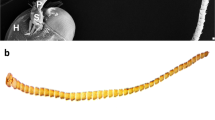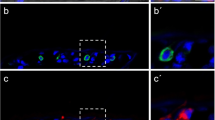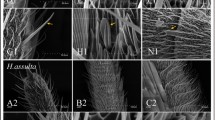Abstract
Pheromone recognition in insects is thought to involve distinct receptor proteins in the dendritic membrane of antennal sensory neurons. We have generated antibodies directed against a peptide derived from the sequence of the candidate pheromone receptor HR13 from Heliothis virescens. The antibodies specifically labelled the cell bodies of a distinct neuron population housed in male-specific pheromone-sensitive sensilla. Combining antibody staining with in situ hybridization the reactive cells were found to express the HR13 gene. In addition, dendrites projecting into sensilla hairs as well as the axonal processes of immunoreactive cells were labelled. Labelling of axons has allowed visualization of their fasciculation within antennal segments and permits tracking of axons as they merge into the antennal nerve. The HR13 protein was first detected 1 day before eclosion. Thus, the distribution of HR13 protein in the antennal neurons of the male moth strongly suggests a role of the HR13 receptor in recognition of pheromones.






Similar content being viewed by others
References
Almaas TJ, Mustaparta H (1990) Pheromone reception in tobacco budworm moth, Heliothis virescens. J Chem Ecol 16:1331–1347
Almaas TJ, Mustaparta H (1991) Heliothis virescens: response characteristics of receptor neurons in sensilla trichodea type 1 and type 2. J Chem Ecol 17:953–972
Baker TC, Ochieng SA, Cosse AA, Lee SG, Todd JL, Quero C, Vickers NJ (2004) A comparison of responses from olfactory receptor neurons of Heliothis subflexa and Heliothis virescens to components of their sex pheromone. J Comp Physiol A 190:155–165
Barnea G, O’Donnell S, Mancia F, Sun X, Nemes A, Mendelsohn M, Axel R (2004) Odorant receptors on axon termini in the brain. Science 304:1468
Berg BG, Mustaparta H (1995) The significance of major pheromone components and interspecific signals as expressed by receptor neurons in the oriental tobacco budworm moth, Helicoverpa assulta. J Comp Physiol A 177:683–694
Berg BG, Tumlinson JH, Mustaparta H (1995) Chemical communication in heliothine moths. IV. Receptor neuron responses to pheromone compounds and formate analogues in the male tobacco budworm moth Heliothis virescens. J Comp Physiol A 177:527–534
Blomquist GJ, Vogt RG (2003) Insect pheromone biochemistry and molecular biology. The biosynthesis and detection of pheromones and plant volatiles. Elsevier, London
Dahanukar A, Hallem EA, Carlson JR (2005) Insect chemoreception. Curr Opin Neurobiol 15:423–430
Dobritsa AA, van der Goes van Naters W, Warr CG, Steinbrecht RA, Carlson JR (2003) Integrating the molecular and cellular basis of odor coding in the Drosophila antenna. Neuron 37:827–841
Elmore T, Smith DP (2001) Putative Drosophila odor receptor OR43b localizes to dendrites of olfactory neurons. Insect Biochem Mol Biol 31:791–798
Eschrich R, Kumar GL, Keil TA, Guckenberger R (1998) Atomic-force microscopy on the olfactory dendrites of the silkmoths Antheraea polyphemus and A. pernyi. Cell Tissue Res 294:179–185
Hallberg E (1981) Fine-structural characteristics of the antennal sensilla of Agrotis segetum (Insecta: Lepidoptera). Cell Tissue Res 218:209–218
Hansson BS (1995) Olfaction in Lepidoptera. Experientia 51:1003–1027
Jacquin-Joly E, Merlin C (2004) Insect olfactory receptors: contributions of molecular biology to chemical ecology. J Chem Ecol 30:2359–2397
Kaissling K-E (1987) In: Colbow K (ed) R.H. Wright Lectures on insect olfaction. Simon Fraser University, Burnaby B.C. Canada, pp 1–75
Klun JA, Bierl-Leonhardt BA, Plimmer JR, Sparks AN, Primiani M, Chapman OL, Lepone G, Lee GH (1980) Sex pheromone chemistry of the female tobacco budworm moth, Heliothis virescens. J Chem Ecol 6:177–183
Koh MA, Park KC, Boo KS (1995) Antennal sensilla in adult Helicoverpa assulta (Lepidoptera: Noctuidea): morphology, distribution, and ultrastructure. Ann Entomol Soc Am 88:519–530
Krieger J, Raming K, Dewer YM, Bette S, Conzelmann S, Breer H (2002) A divergent gene family encoding candidate olfactory receptors of the moth Heliothis virescens. Eur J Neurosci 16:619–628
Krieger J, Grosse-Wilde E, Gohl T, Dewer YM, Raming K, Breer H (2004) Genes encoding candidate pheromone receptors in a moth (Heliothis virescens). Proc Natl Acad Sci USA 101:11845–11850
Kumar GL, Keil TA (1998) The phenomenon of “beading” in olfactory dendrites of the male silkmoth Antheraea pernyi Guérin-Ménéville (Lepidoptera: Sarturniidae). Int J Insect Morphol Embryol 27(3):179–183
Larsson MC, Domingos AI, Jones WD, Chiappe ME, Amrein H, Vosshall LB (2004) Or83b encodes a broadly expressed odorant receptor essential for Drosophila olfaction. Neuron 43:703–714
Oland LA, Tolbert LP (2003) Key interactions between neurons and glial cells during neural development in insects. Annu Rev Entomol 48:89–110
Picimbon JF, Dietrich K, Krieger J, Breer H (2001) Identity and expression pattern of chemosensory proteins in Heliothis virescens (Lepidoptera, Noctuidae). Insect Biochem Mol Biol 31:1173–1181
Renou M, Lucas P (1994) Sex-pheromone reception in Mamestra brassicae L. (Lepidoptera)—responses of olfactory receptor neurons to minor components of the pheromone blend. J Insect Physiol 40:75–85
Rogers ME, Sun M, Lerner MR, Vogt RG (1997) Snmp-1, a novel membrane protein of olfactory neurons of the silk moth Antheraea polyphemus with homology to the CD36 family of membrane proteins. J Biol Chem 272:14792–14799
Rutzler M, Zwiebel LJ (2005) Molecular biology of insect olfaction: recent progress and conceptual models. J Comp Physiol A Neuroethol Sens Neural Behav Physiol 191:777–790
Schwarzenbacher K, Fleischer J, Breer H (2005) Odorant receptor proteins in olfactory axons and in cells of the cribriform mesenchyme may contribute to fasciculation and sorting of nerve fibers. Cell Tissue Res, pp 1–9
Strotmann J, Levai O, Fleischer J, Schwarzenbacher K, Breer H (2004) Olfactory receptor proteins in axonal processes of chemosensory neurons. J Neurosci 24:7754–7761
Teal PEA, Tumlinson JH, Heath RR (1986) Chemical and behavioral analyses of volatile sex pheromone components released by calling Heliothis virescens (F.) females (Lepidoptera: Noctuidae). J Chem Ecol 12:107–126
Tolbert LP, Matsumoto SG, Hildebrand JG (1983) Development of synapses in the antennal lobes of the moth Manduca sexta during metamorphosis. J Neurosci 3:1158–1175
Tolbert LP, Oland LA, Tucker ES, Gibson NJ, Higgins MR, Lipscomb BW (2004) Bidirectional influences between neurons and glial cells in the developing olfactory system. Prog Neurobiol 73:73–105
Acknowledgements
The authors thank Prof. R. Wurster (Institute of Physics and Meteorology, University of Hohenheim) for making the scanning electron micrographs. We are grateful to Klaus Raming and Gerd Trautmann (Bayer CropScience) for cooperation and providing pupae of H. virescens and to Prof. H. Breer (Institute of Physiology, University of Hohenheim) for valuable advice and support. This work was supported by the Deutsche Forschungsgemeinschaft (grant KR1786/3-1 to J.K.).
Author information
Authors and Affiliations
Corresponding author
Rights and permissions
About this article
Cite this article
Gohl, T., Krieger, J. Immunolocalization of a candidate pheromone receptor in the antenna of the male moth, Heliothis virescens . Invert Neurosci 6, 13–21 (2006). https://doi.org/10.1007/s10158-005-0012-9
Received:
Accepted:
Published:
Issue Date:
DOI: https://doi.org/10.1007/s10158-005-0012-9




